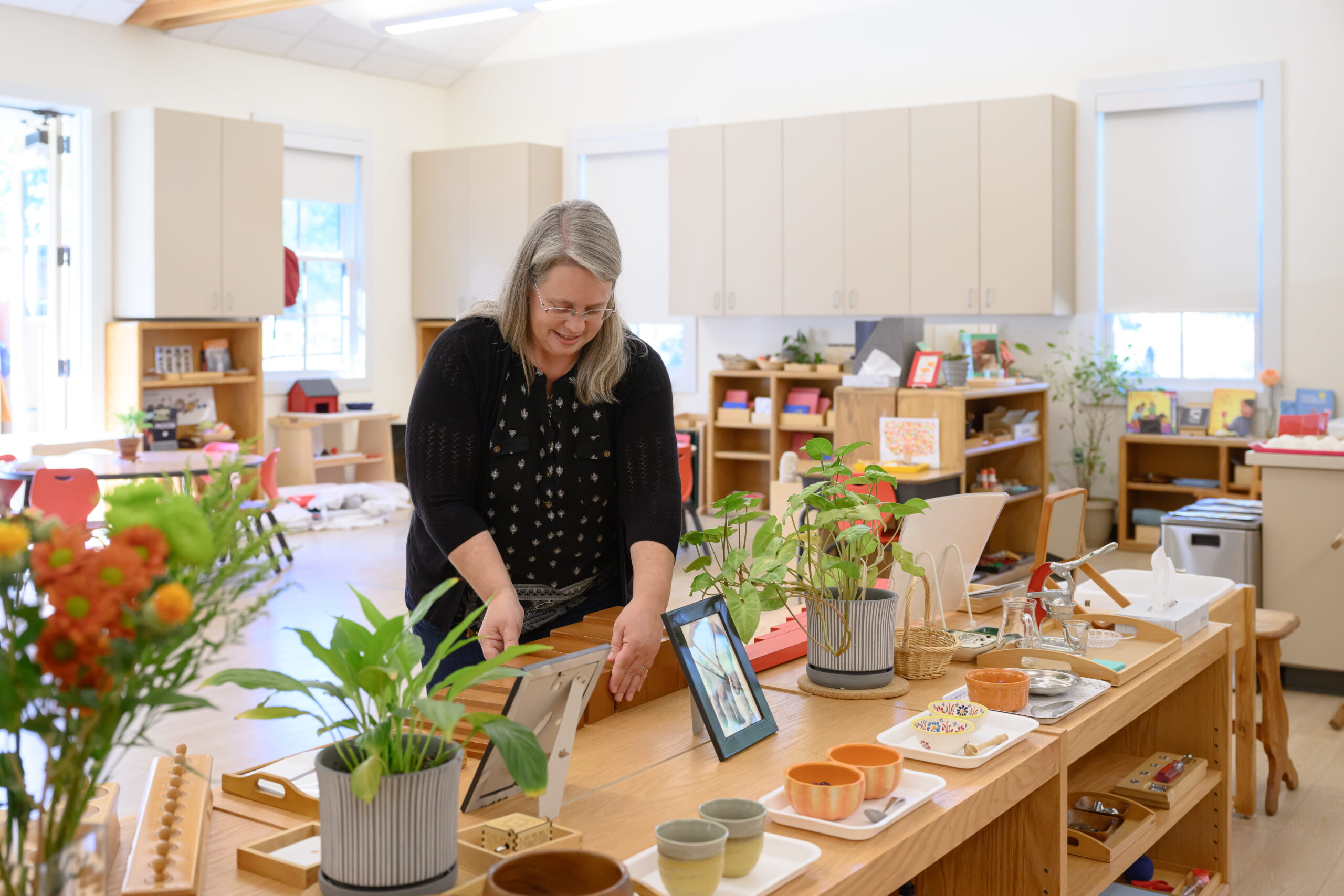The Montessori teacher is constantly looking for a child who is not there…The teacher, when they begin work in our schools, must have a kind of faith that the child will reveal themself through work.” (Montessori, 1967, p. 276)

This article was featured in our 2024 Spring edition of Montessori Life magazine. Read the full issue online (AMS members only).
AMS members also receive a print subscription to Montessori Life magazine. Become a member today to receive your own subscription plus access to the complete digital archives.
As a new teacher, I wanted to do this work well.
I loved Montessori. I believed in Montessori. I could clearly see the child who was not yet there, just like Maria Montessori described in The Absorbent Mind. And I was determined to get that child into my classroom.
Then the actual work started. The real children entered my classroom. I could still imagine the child who was not yet there, but the present-day child, who was sometimes loud and didn’t slide into a peaceful trance when working with the Pink Tower, was very much there with me in my classroom.
In my quest to do this work well, I asked many questions of my colleagues. Questions like, “What do you do when the children aren’t working with the Pink Tower carefully?” And “What do you do when one child heads to the snack table first thing and chats all morning?” I listened to what other teachers said and quickly realized that there weren’t many definite answers. Sure, I got answers that felt like they could do the trick: “Only allow two children to use the Pink Tower at once.” Or “Make sure they do three works before they are allowed to eat a snack.” Those answers, which sometimes presented very clear solutions to my problems, didn’t always feel right, but they almost always felt helpful. And the answers that did feel right didn’t always feel helpful.
The answers that felt right weren’t the answers I was expecting. The seasoned teachers I felt most inspired by would usually follow up with a question instead of a solution. “How are you presenting that lesson? What games have you shown them?” Or “What materials or activities does this child like best?” “Do the other children give him feedback when he doesn’t move along quickly, so someone else can have a turn at the snack table?” I often didn’t have the answers to these follow-up questions—and I realized it was because I hadn’t been observing. And I hadn’t been observing because I was instead spending time trying to figure out how to get the children not yet there to appear in my classroom.
Am I the only one? Have you ever found yourself trying to figure out how to call to the children who are not yet there? Where are the peaceful, content children that were described in Montessori’s writings? In our impatience, we implement tips and tricks to get them there faster, to pry out the children who are not yet there. Two works before you can have a snack. This is a one-person work. That is a two-person work. And suddenly, things feel calmer, quieter. And I feel in control.
The children are working, and the environment feels calm. I can give lots of lessons. These rules and “tricks” obviously work. This is a peaceful classroom. But is “a peaceful classroom” the goal? Or is there a larger goal—and a peaceful classroom is just one of the outcomes of that larger goal? Have we forgotten about the larger goal because we’ve gotten happy and content with the shorter-term goal? Have we confused peaceful with quiet?
Rules are necessary. Children need clear guidelines and boundaries to be joyful in a community with one another. In fact, Montessori prescribed it. But are we putting ground rules in place and forgetting to keep observing?
Are we using systems like a one-person work and two-works-before-snack as substitutes for the spiritual preparation of the adult? Are we manufacturing these peaceful environments instead of letting them form naturally through self-discipline and normalization? In all my readings of Montessori’s work, I can’t recall her referring to “one-person work” or any of the other common ground rules that many Montessori schools keep in place.
Has our idea of peaceful become conflated with the American idea of compliant? Montessori came to the United States at the turn of the 20th century, and the Method was, at first, accepted with enthusiasm. Wealthy white Americans were thrilled to learn about young children reading and writing at such early ages (Whitescarver & Cossentino, 2008).
But it wasn’t long before the honeymoon was over—American educators wrongfully accused Montessori of being behind the times of educational research of the day. One of these early criticisms of Montessori education targeted the amount of freedom given to children. The perceived wisdom of the era viewed teachers as the center of the classroom, and Montessori’s critics were uncomfortable with the concept of decentering the adult to educate the child (Thayer-Bacon, 2012). This teacher-centric norm persists today in traditional education—and in fact, it is the way many of us were educated as children. With this in mind, I ask again: Are our current norms of peaceful and quiet viewed through the lens of traditional American education? Do we understand “peaceful” to mean “compliant”?
And what does this mean for cultures who do not have the same values around “peace and quiet”? In what ways does this idea of peaceful and quiet impact the neurodivergent children in our environments? As the parent of two neurodivergent children, I can tell you that a child with hyperactive ADHD isn’t going to be quietly working alone most of the time. Is this expectation forcing children to show up inauthentically, because their real selves are too loud for the classroom?
A Montessori classroom should run on self-regulation, personal responsibility, and social harmony—not adult-imposed rules.
Does this mean we have no rules and let the children do whatever they want? Of course not! Normalization cannot be achieved in chaos. Children need order, and adults must create an orderly environment. But how do we do that without ground rules and conventions? It requires a prepared adult.
 The prepared adult. It sounds simple, but normalization and a culture of community can only happen with a prepared adult. A prepared adult does not measure their work by how quiet their classroom is. They are not threatened by increased volume or energy levels. They do not take unwanted behavior personally. A prepared adult does not strive to control behavior. And a prepared adult does not interrupt developmental work, no matter how painfully slow it may be.
The prepared adult. It sounds simple, but normalization and a culture of community can only happen with a prepared adult. A prepared adult does not measure their work by how quiet their classroom is. They are not threatened by increased volume or energy levels. They do not take unwanted behavior personally. A prepared adult does not strive to control behavior. And a prepared adult does not interrupt developmental work, no matter how painfully slow it may be.
A prepared adult allows children to practice essential executive functions and self-regulation skills like working memory, mental flexibility, and self-control. These skills aren’t just a “Montessori thing.” According to the Harvard University Center on the Developing Child, opportunities to develop these skills have lifelong benefits to the child. Building self-regulation skills in a classroom setting can even be a protective factor for young children who are experiencing stress in other parts of their life (Rosanbalm & Murray, 2017). But what happens when a room is full of people practicing skills like working memory and self-control that they haven’t mastered, especially when those people are 3- to 6-year-old children? It can feel chaotic. The volume can get loud. Does this chaos and volume feel counterintuitive to what we imagine about the ideal Montessori environment? To attain a peaceful, quiet classroom, are we stifling opportunities for children to practice important executive functions and self-regulation skills by putting certain ground rules into place? Think about your own beginning-of-the-year routines. Is the time consumed with Grace and Courtesy bootcamp and reminders on ground rules? Or do you dedicate time to observing and building community among the children? How can we be prepared adults who build a tolerance for the chaos that can come from allowing children opportunities to practice their skills? We must walk a fine line.
“The adult must give and do what is necessary for the child to act for himself; if he does less than is necessary, the child cannot act meaningfully, and if he does more than is necessary, he imposes himself upon the child, extinguishing his creative impulses. One can determine the limit, or what we call the ‘threshold of intervention.’ This determination becomes more precise as, step by step, we accumulate experience with our guide. The necessary understanding between the adult educator and the child clarifies itself even more exactly.” (Montessori, 1975, p. 69)
Sounds easy, right? Do what is necessary. Nothing more and nothing less. That sounds simple enough, Madam. (I hope you can sense the sarcasm.)
Walking this fine line can feel impossible; we can find ourselves swinging far too permissive or far too rigid. But along with Montessori’s theories on this idea of a threshold of intervention, we’ve got some research to help guide us. According to a study in the Journal of Child and Family Studies (2012), factors like income and parent education levels did not have a significant impact on children’s self-regulation skills. Instead, what made the biggest impression was parenting styles; research suggested that both excessive parental control (authoritarian parenting) and excessive child control (permissive parenting) both had negative effects on a child’s self-regulation skills. While this research looked specifically at parents, we can extend the logic to the type of adult behavior that best supports self-regulation skills. The study specifically looked at adult follow-through to gauge permissive parenting. Follow-through is a major part of walking this fine line of doing no more or less than is necessary. A prepared adult is prepared to follow through. And a prepared adult is careful about what they say—they never create mandates they aren’t willing to follow through on or set ground rules they aren’t willing to enforce with everyone. A prepared adult says what they mean and means what they say.
A prepared adult is prepared for dysregulated behaviors. Yes, ideally children learn self-regulation skills and executive functions sooner rather than later. But dysregulated behaviors, like tantrums, shouting, and occasionally hitting, are inevitable in an Early Childhood classroom, where children are practicing self-regulation and executive function skills, and while we do not want to condone that behavior, we do not want to create stigma around it. As children develop social cohesion, another phenomenon that Montessori described in The Absorbent Mind (and which current researchers call social agency), they guide each other. When one child makes a big mess, the others run to help. When one child has a shouting fit, the others learn what helps them feel calm. This is something that cannot be achieved with a necklace system or with an expectation that dysregulated behavior does not happen in a Montessori classroom. Montessori knew that children learn valuable social skills by living their lives together. A prepared adult creates an environment for children to practice these skills by living their lives together; a prepared adult stays out of their way as much as possible.
A prepared adult understands the importance of a prepared environment. The prepared environment is not just about the physical objects in the environment but also about preparing a supportive social environment. One prime example of the prepared environment supporting emotional regulation is the number of materials available. There is one of everything. No matter your training, Montessorians can agree on this one. If something a child wants to use is being used by someone else, their only choice is to wait. During this waiting, they face disappointment and decide what to do with it. “Since this happens every hour of the day for years, the idea of respecting others, and of waiting one’s turn, becomes a habitual part of life which always grows more mature” (Montessori, 1967, p. 224). In Montessori’s words, the children in her schools “live always in an active community” (1967, p. 225). Can we have this kind of active community, where things like taking turns become habitual, when conventions like one-person tables and two-person activities often direct self-regulation?
Most important, a prepared adult observes. Observation is the secret sauce of the Montessori Method; without it, there is no Montessori Method. Everything we do in the classroom, from the lessons we give to how the furniture is arranged, should be based on observation. A prepared adult is a keen observer and should always be observing—and not just during “work time.” A prepared adult observes the children as they hang their coats, have snacks, and play outside. Montessori prescribed observation as the guide’s foundational tool; it is the most essential task in our job description.
Let’s look back at that common question about what a teacher should do if a child isn’t working carefully with the Pink Tower. You’ve observed the misuse of the material. What do you do with that observation? You could do so much based on what you see. If the child is using the Pink Tower for imaginative play, maybe they need a presentation on a variation or extension to inspire more meaningful use. If the child is disturbing peers around them, perhaps they need this to be a partner-work to meet a social need. You could invite that child and a peer to play a distance game or do a variation together. Is there a gross-motor need that could be met in a different part of the classroom? Maybe you could plan a new lesson that might satisfy a need they are trying to fulfill with this material. But we can’t do any of this unless we observe. When we think we must do something about an unwanted behavior, remember this: Observation is doing something.
How many ground rules, how many designated one- or two-person works would we need if we took time to observe what is really happening? Ground rules are helpful; there are times when we must place limits in the classroom. But we can’t stop there. We can’t put the limits in and keep going. We must keep observing. The question isn’t what rule could solve a certain issue but rather what the issue’s root cause is. The limits shouldn’t become a prescription to a peaceful classroom but rather a means to a larger goal. And that goal is self-regulation. That goal is a normalized community. For every ground rule we put into place, we should create a plan to remove it, and that plan must include observation.
 One of my favorite passages by Montessori is in The Absorbent Mind. In chapter 23, “Social Development,” she writes with warmth about the community of children that are “cemented by affection….The children come to know one another’s characters and to have a reciprocal feeling for each other’s worth” (1967, p. 227). By the time she wrote these words, Montessori had observed communities of children from vastly different backgrounds. She had seen this repeatedly—communities of children cemented by affection. Self-regulation must fuel this kind of community, not a prescribed set of rules. How lucky to be the adults that get to facilitate this! We must prepare ourselves to be the kind of adults that can wait patiently for the children who are not yet there, while teaching the ones currently present with us in our classrooms. We don’t have to prod them with rules and conventions. We must keep observing, preparing the environment, and preparing ourselves. They’ll find their way in—if we create the path.
One of my favorite passages by Montessori is in The Absorbent Mind. In chapter 23, “Social Development,” she writes with warmth about the community of children that are “cemented by affection….The children come to know one another’s characters and to have a reciprocal feeling for each other’s worth” (1967, p. 227). By the time she wrote these words, Montessori had observed communities of children from vastly different backgrounds. She had seen this repeatedly—communities of children cemented by affection. Self-regulation must fuel this kind of community, not a prescribed set of rules. How lucky to be the adults that get to facilitate this! We must prepare ourselves to be the kind of adults that can wait patiently for the children who are not yet there, while teaching the ones currently present with us in our classrooms. We don’t have to prod them with rules and conventions. We must keep observing, preparing the environment, and preparing ourselves. They’ll find their way in—if we create the path.
References:
Harvard University Center on the Developing Child. (n.d.). Executive function &
self-regulation. https://developingchild.harvard.edu/science/key-concepts/executive-function/
Montessori, M. (1967). The absorbent mind. Holt, Rinehart & Winston, pp.
224–225, 227, 276.
Montessori, M. (1975). The child in the family. Montessori-Pierson, p. 69.
Piotrowski, J. T., Lapierre, M. A. & Linebarger, D. L. (2012). Investigating
correlates of self-regulation in early childhood with a representative sample of
English-speaking American families. Journal of Child & Family Studies, 22(3),
423–436. https://doi.org/10.1007/s10826-012-9595-z
Rosanbalm, K. D. & Murray, D. W. (2017). Promoting self-regulation in early
childhood: A practice brief. OPRE Brief #2017-79. Washington, D.C.: Office
of Planning, Research, and Evaluation, Administration for Children and
Families, U.S. Department of Health and Human Services.
Thayer-Bacon, B. J. (2012). Maria Montessori, John Dewey, and William H.
Kilpatrick, Education and Culture, 28(1): 3. https://docs.lib.purdue.edu/eandc/vol28/iss1/art3
Whitescarver, K., & Cossentino, J. (2008). Montessori and the mainstream:
A century of reform on the margins. Teachers College Record, 11
About the Author
 |
Margaret Beagle, MEd (she/her), is a Primary guide at Montessori Academy in Nashville, Tennessee, where she lives with her husband and three children. She is AMS-credentialed (Early Childhood). Find her at www.wholechildcollaborative.com.
|
Interested in writing a guest post for our blog? Let us know!
The opinions expressed in Montessori Life are those of the authors and do not necessarily represent the position of AMS.


